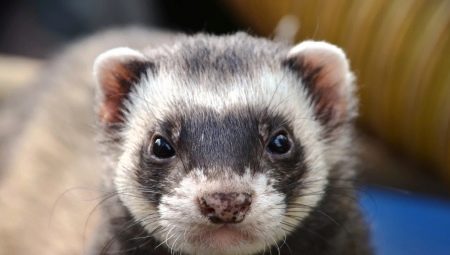Many of you probably have or had some kind of pet. It’s pleasant for everyone to have their own pet, take care of it, play and just have a good little friend. Have you ever thought that, in addition to the usual cats, dogs, parrots and fish, you can get yourself some unusual animal, for example, a ferret? In order to understand whether it is worth acquiring such a beast, we suggest learning a little more about this animal.
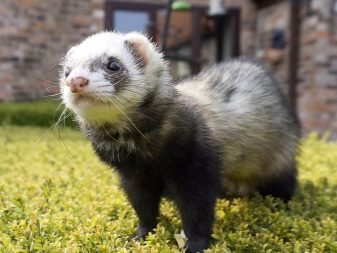
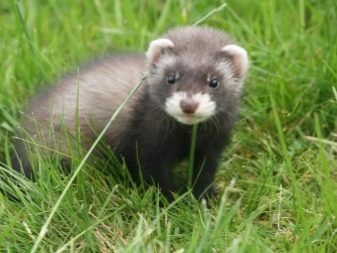

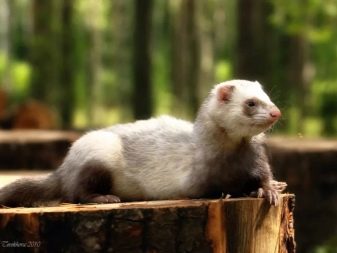
Description
The ferret is a medium-sized mammal, belongs to the family of marten, is a predator. The ferret in general looks very cute: a slender elongated body, a long neck, and a fluffy tail. Special glands are located in the tail area, thanks to them secretion is released with a characteristic smell. The ferret can be in length from 30 to 50 cm, and the weight varies from 300 g to 2 kg. In wild conditions they live for about 3-4 years, in case of domestication - up to 7-8 years.
Despite the small short legs, the ferret is able to move quite quickly, and with the help of strong claws it can nimbly climb trees and dig holes. A special advantage of ferrets is their fur. Its main component is a dense undercoat and outer hair, light at the roots and dark at the ends. Wool looks much better in the fall, after molting, becoming more smooth and shiny.
As a habitat, they prefer forest edges, steppe areas, and also love places near ponds. Often ferrets settle in burrows, choosing a warm, cozy place. They do not like to live in dense taiga or in too open areas. Sometimes they settle near human houses.They prefer to stay alone, without forming a flock.
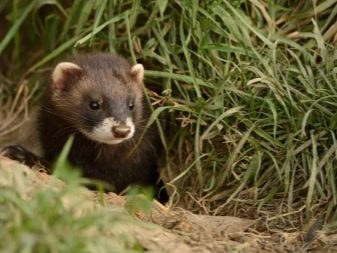


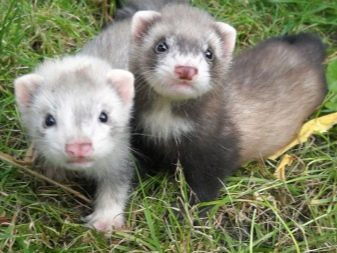
Ferrets lead a more active lifestyle at night, but can hunt in the daytime. By nature, these animals are quite aggressive and bold, and in matters of obtaining food they are not afraid to engage in a battle with predators, greatly exceeding them in size. Their prey is small rodents (field voles, hamsters, ground squirrels, squirrels), lizards, birds and their eggs. Also, ferrets do not mind eating worms and various insects. Due to the peculiarities of their digestion, vegetation is not eaten, and a lack of nutrients is obtained by eating small herbivores. In rare cases, they can eat carrion for some time.
Despite the courage with which they enter the struggle for food with other predators, some animals in the forest pose a danger to them. Ferrets should be wary of foxes, wolves, as well as large birds: golden eagles and eagle owls. Man also poses a certain threat to these animals. If ferrets live somewhere near a person’s house, in pursuit of beautiful fur, people are able to ruthlessly exterminate these furry handsome men. It is worth noting that some species of ferrets are listed in the Red Book, so they must be protected.

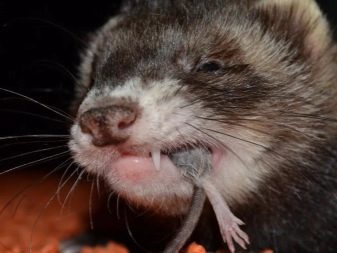


Advantages and disadvantages
Before you start a ferret, it is worth considering all the nuances associated with the care and maintenance of this furry handsome. You can read the reviews of the owners, consult with consultants in pet stores, in general, be knowledgeable in this matter. Consider the advantages of acquiring such an animal.
- Funny company. If this animal settles in your home, you will definitely not be bored - a mischievous and playful animal will help to cheer you up with your funny jumps and games. In addition, it is always pleasant to pick him up and stroke him, because he has such a soft and beautiful fur.
- Easy learning. The ferret is a pretty quick-witted creature, so it can be taught some simple commands. Some instances are even amenable to training, which is an additional advantage.
- Simple care. Caring for a ferret is not difficult, however, it is important to remember that this animal quickly adapts to the new situation and after a while it will look for unexplored territory for entertainment, and you need to be prepared for this. Due to the flexibility in training, it will not be difficult to train the animal to the toilet, which will greatly facilitate your life.
- Coincidence in biorhythms. Tends to establish the same rhythm with the owner. Despite the fact that he is used to lead a nocturnal lifestyle, he will not be very distracting with his noise if everyone is already sleeping.
- No need for frequent walking. You can keep your pet in the apartment for a long time and not worry that it’s time to walk, it saves time pretty well and is suitable for people who are constantly in a hurry in the morning to work.
- Compactness. Due to its size it is a compact animal, some even put it in a purse, and so go out with it for a walk.
- Help with rodents. If you live in a private house and are tired of fighting small rodents, perhaps the ferret will help to solve this problem, because it catches mice perfectly.
- The same behavior. After castration, unlike other animals, they do not change their behavior, do not begin to be more lethargic, lazy, but, on the contrary, they are still cheerful, cheerful and always ready to have fun with you.
- Almost hypoallergenic. There is an opinion that the hair of ferrets is less allergenic, unlike other animals, which, undoubtedly, is a big plus for people suffering from this ailment.
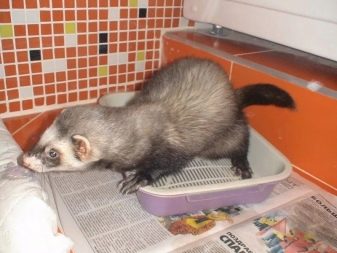


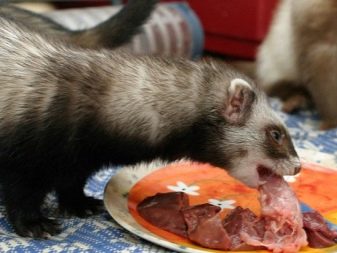
But, despite the rosy picture described above, there is, of course, the flip side of the coin. Not everything is as smooth as we would like.
- Each animal has its own smell, and in ferrets it is particularly specific, gives in musk, so not everyone will like it.Such a strong “aroma” is obtained due to the very glands, thanks to which they secrete a secret for the label of the territory. But we solve this question: it can be neutered if it is male or sterilized if female, and then the smell problem will be eliminated.
- The content of such a fluffy is not a cheap pleasure, it is necessary to spend a decent amount every month on creating and maintaining all comfortable conditions, and this is not everyone can afford.
- Despite the fact that the ferret is quite simply accustomed to the toilet, he will just as easily and quickly find himself a new place in order to cope with his needs. Therefore, if you don’t have time to clean the tray in time, you can safely search for “surprises” in the most unexpected places around the house, which is not so nice.
- Ferrets tend to hide various objects and things they like, so you need to be prepared for the fact that you may not be able to count some hairpins, cents or find your mittens torn.
- If a ferret lives in your house, then most likely the flowers will not stand for a long time. The thing is that as soon as this animal finds access to flower pots, then, following instinct, the ferret will certainly begin to dig into them, dig a mink or turn over. Therefore, alas, you will have to say goodbye to flowers.
- Since the ferret is by nature a predator, it is not worthwhile to start any small pets (such as hamsters, parrots, guinea pigs) with it, otherwise it will begin to hunt them at the first opportunity.
Of course, if any information seemed unacceptable to you or scared you off, then, of course, you should once again weigh the pros and cons, and only then make a final decision. In any case, no one forces you to start a ferret. But if you still get it, then a fun life is provided for you.

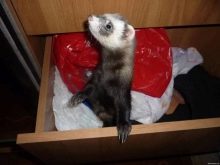

Popular decorative colors
Before we talk about the different colors, it is worth talking about the main types of ferrets, describe their appearance and main characteristics. So, there are some of the most common types of ferrets: steppe, forest, black-footed and ferret. Let's consider them separately.
Steppe (light, white)
The steppe ferret - one of the largest representatives of its species, can reach a length of 56 cm, and its weight sometimes reaches 2 kg. Based on the name, one can guess that in As a habitat, animals prefer the steppe, semi-desert places, deposits. They are called light due to the coloring of the fur.
Upper hair, as a rule, is black or dark brown in color, and a dense dense undercoat that breaks through a thin hairline has a fairly light shade. On the face there is a characteristic pattern in the form of a black mask. They live one at a time, but group coexistence is also possible. They feed on gophers, hamsters, snakes, frogs. Females of this species of ferrets are very prolific, they are able to breed up to 18 puppies.


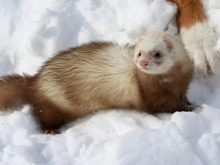
Forest (black, dark or ordinary)
In size, it is slightly smaller - about 35-47 cm, body weight - from 400 g to 1.5 kg. It is mostly black and brown, and the legs and tail are almost completely black. A characteristic mask is also present on the face. It feeds on rodents, frogs, birds and their eggs. Compared to the steppe ferret, females of this species do not bring many cubs - only about 4-6 puppies.



Blackfoot (American)
A predator of a rather rare species, is on the verge of extinction and is listed in the Red Book. It reaches a length of about 30-40 cm, and the weight of the animal is from 650 g to 1 kg. The color of the fur at the base of the hair is light and dark at the ends, a characteristic black mask on the muzzle is also present. The nature of the food does not differ significantly from other representatives, the only peculiarity is meadow dogs, whose survival depends on the population of the American ferret.
But in order that this species did not disappear completely, some representatives were caught for cultivation and breeding in artificial conditions in order to preserve this population of ferrets.


Ferret (Furo, home or African)
It is one of the domesticated species of ferret, although the term "furo" scientists have designated ferrets, which, unlike others, are albinos. And a ferret of any kind that a person tamed and settled in his house can be considered domestic. According to the main indicators, this type of ferret resembles the steppe, the body length is also about 50 cm, and weight - from 700 g to 2 kg.
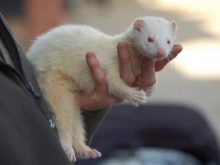
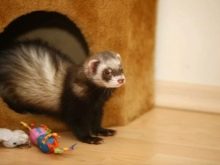
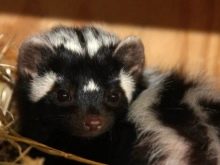
There is another species - the golden ferret. It was bred by crossing a ferret and a forest ferret. This representative has a thick long fur, black outer hairline and an orange down, for which he received this name. It is also necessary to note the species called Honorik, he appeared by crossing mink and ferret.
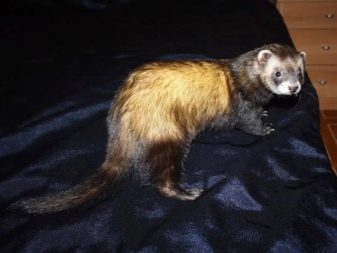
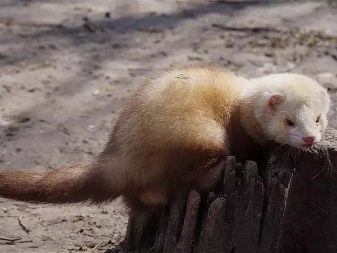
Despite such a number of species, the different color options of these animals are striking in even greater variety. Based on a huge number of all kinds of colors, they still decided to separate them according to certain criteria. Classifications began to include such signs as:
- coloring, color - what color is the body, nose, eyes, limbs;
- the presence of marks, the location of spots on the body;
- mask on the face - its color, as well as the presence or absence;
- fur pigmentation: silver, black, sable, chocolate.
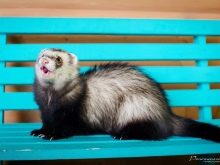

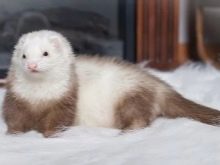
In the wild, color options for ferrets can be monochrome: completely red or completely brown, black. If we are talking about domesticated pets, then there are definitely more color options, here are the most common:
- white black-eyed - there is a certain resemblance to albinos due to a similar white color, but their eyes are black and their nose is pink;
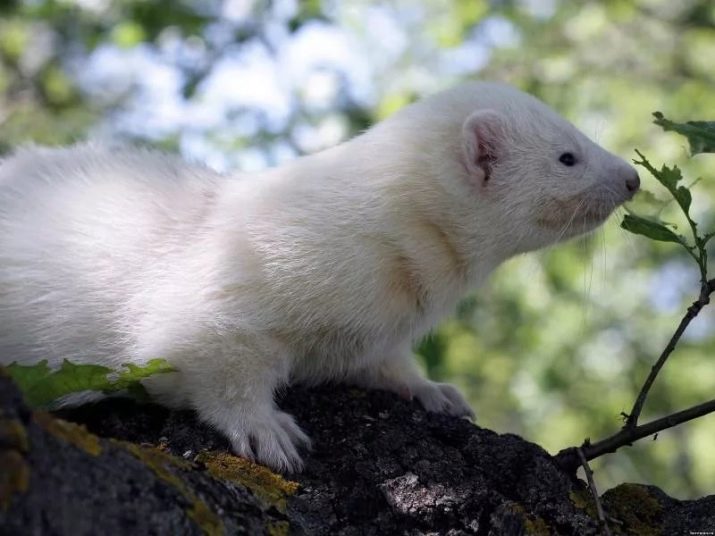
- albino - the peculiarity of this representative is his coat, which has a characteristic white or powder color, the down is also white, there are small red eyes;
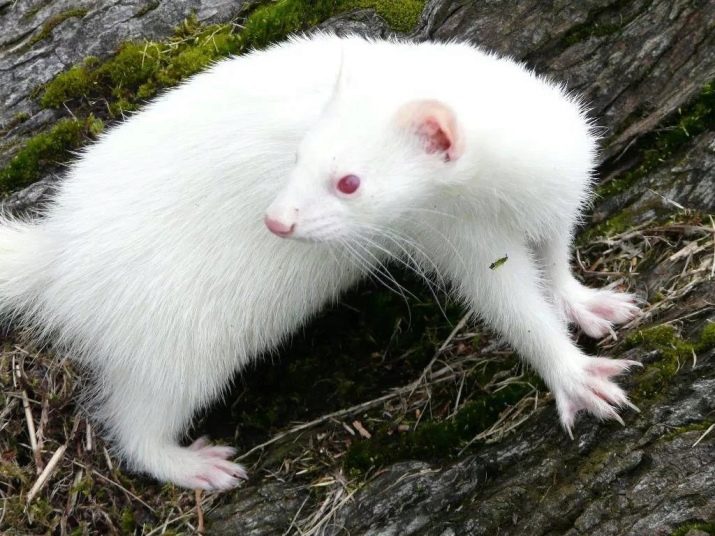
- champagne - a shade of noble beige or milk chocolate, the down is light or completely white, there are also golden and powdery shades;

- cinnamon (cinnamon) - a rather interesting coloring, the outer hair of a noble light brown color, toward the tail it becomes darker, and the down is beige;
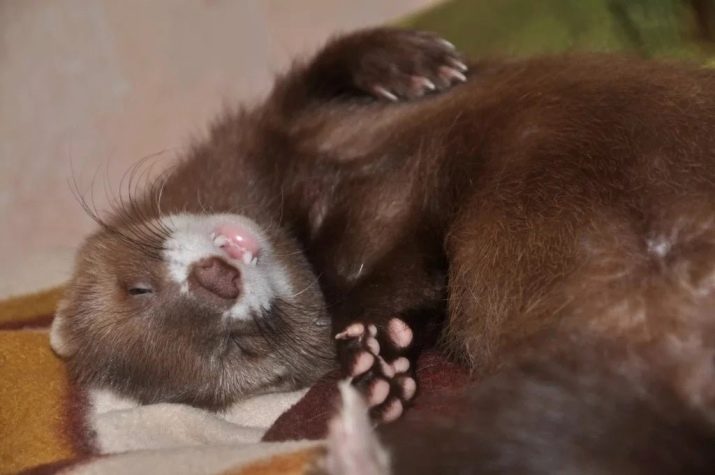
- panda - a white small head and chest, paws and tail are dark in color (often ferrets of this species are deaf, this is due to a genetic predisposition);
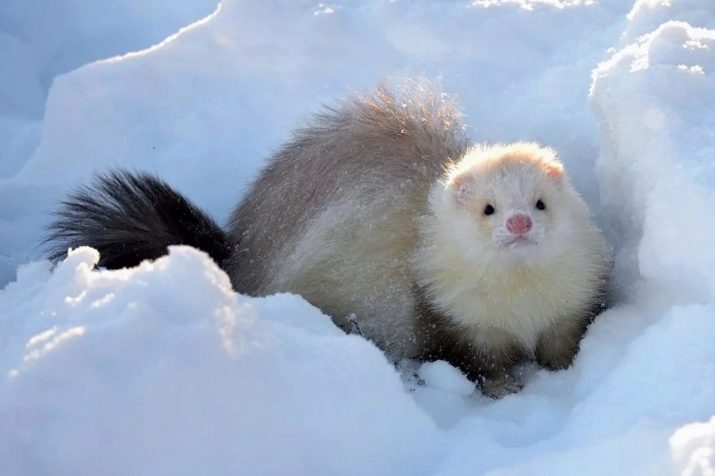
- Siamese color - the coat is mostly dark in color; a V-shaped black mask is located on a light muzzle.
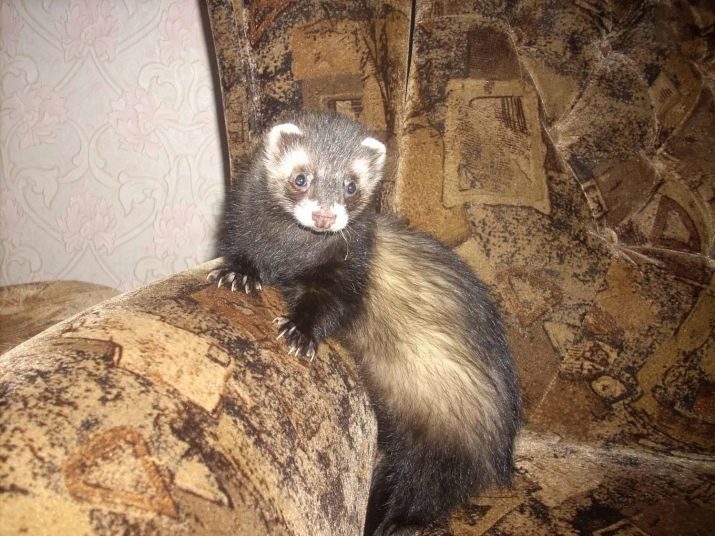
In addition to the types of colors described above, the classification of ferrets by species also takes into account:
- the presence of spots and their location;
- all kinds of marks.
How to tame?
Judging by the above characteristics, it becomes clear that the ferret is a rather aggressive and fearless animal, has a rather complex character and is kept alone. Therefore, if you decide to take a ferret home, then, of course, it is worth choosing from home species. It is important to remember that the process of taming will require you to have sufficient endurance and a certain amount of time. Be patient and remember the main points.
First you need to know in what age period it is better to take ferrets. The optimal age is about 4 weeks, since the baby has already received the main care and nutrition from the mother, and there is still time before becoming an adult. On average, the taming process takes about 2-3 weeks, taking into account all the necessary rules.
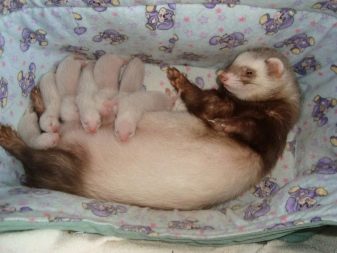
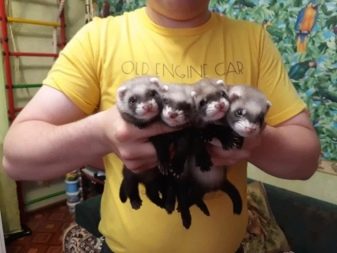
Another important condition for taming is your own safety. While the processes of grinding to each other will take place, it is best to take care of how to avoid the negative consequences of the untamed ferret.Given the characteristics of his behavior, it is possible that You will have to deal with his bites more than once, so it’s better to approach a new friend in thick gloves.
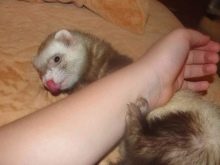

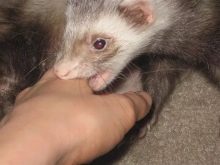
One of the most common and effective ways to tame new pets in the house is, of course, to lure the animal with some kind of edible treat for him. But before you treat your new friend, study his diet, find out what kind of food can be given to him, which one cannot, otherwise you risk ruining the whole plan of taming.
At the beginning of this difficult path, you should have patience and strength, and understand that the main thing is not to break. As soon as you begin to feed the ferret, take a small piece of the treat, put it in your hand and extend your hand. When the animal comes to you, it is important to remain calm and not make sudden movements, so as not to frighten him. First he comes up, sniffs everything, studies the situation, and only when he is convinced of safety can he come up and take food from your hands. If this happens, then this is the right path to success.


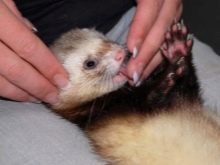
Then you can proceed to the next step. After the ferret begins to take the goodies out of your hands, most likely he trusts you, and perhaps dares to eat right from the palm of his hand. But do not immediately grab it for joys and try to stroke it, you can frighten it off. Give him some more time to get used to you. When you see that the animal shows confidence, is not afraid of a new owner, does not behave cautiously, eats calmly from his hands, then you can slowly try to pick it up and stroke it.
It is important not to rush in this matter, and to show maximum patience. Next, try to increase the time the ferret stays in your arms. When he falls asleep, you can gently pick him up and hold him a little longer than usual, stroke, warm.
Of course, waking up, he will be surprised at how you ended up with you, but let him know that you have exclusively good intentions. Then the animal will feel your good promise, and contact will be made.
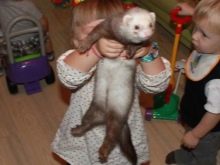

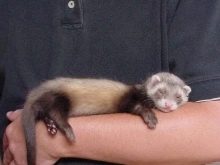
If you still decide to start an adult ferret, all taming techniques, in general, do not differ, but it is important to remember that we are talking about an adult with its own character, accustomed to living in certain conditions. And for a wild adult ferret to become tame, it takes a little more time.
If your ferret begins to behave rather shyly, arranges riots, bites, you need to take decisive action. It is important to try to correctly explain the animal that its behavior is inappropriate. If he bit you on the finger (during the game or in a fit of anger), you need to immediately stop these tricks and make it clear that you can’t do this. You can bite it in response (for the withers) or give a small click on the nose.
Perhaps, in order to wean him from these harmful habits, it will take more than one day, but the main thing is to achieve a positive result.

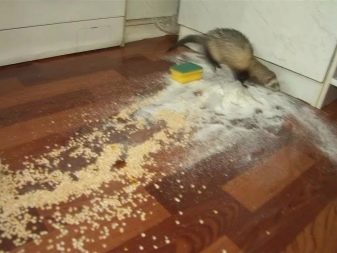
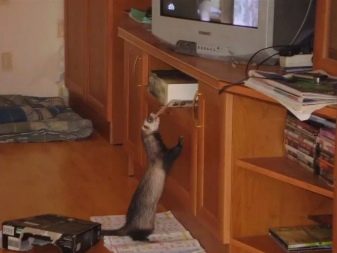
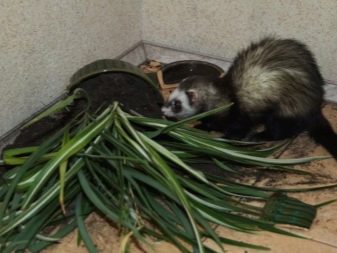
Care and maintenance
And now that we have described all the features, pluses and minuses of animals, it is worthwhile to dwell in more detail on what conditions need to be created if you decide to keep a ferret at home.
First you need to take into account some points.
- Do not leave windows open, otherwise an accident may occur.
- Eliminate all kinds of gaps where the ferret can penetrate so that it does not get stuck.
- In the place where it will be located, it is advisable to remove tall objects, otherwise the ferret can climb on them and accidentally fall.
- With sharp teeth and claws, pets can chew and scratch the furniture, so you should come up with a special place where they can play without fear of spoiling anything.
- In summer, avoid excessive exposure to sunlight in the room where the ferret dwells, as the animal may overheat due to thick fur. To avoid this, it is worth putting a fan.
- Do not leave the toilet lid raised, otherwise your pet may get there and drown.
- Carefully hide the various household chemicals, as the ferret can accidentally stumble on them and decide that it is something edible.
- The ferret is very fond of toys, so that he does not spoil your things during the game, buy special rattles in the store that will amuse your baby.
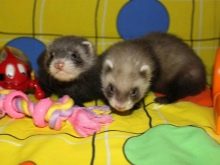
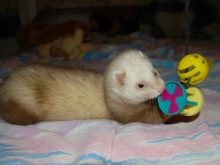
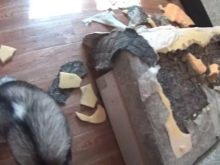
Housing Features
Of course, the best option for the ferret would be if he would give the whole room at his disposal, since this animal loves freedom very much. But in this case, you will have to constantly catch him throughout the apartment, to see that he does not mess up anywhere, in general, the trouble with him will be much more than with any other pet. Therefore, it is worth thinking about some limited space.
A cage is a good option for a ferret. But before you buy it, it is worth considering some nuances. The cage should be quite large so that your pet feels spacious in it and can happily run and play. For greater coziness and convenience of your ferret, inside the cell you can make various mazes, stairs or install a small hammock.
In general, put everything that comes to mind so that your little animal does not get bored there.
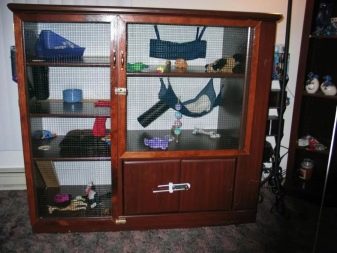
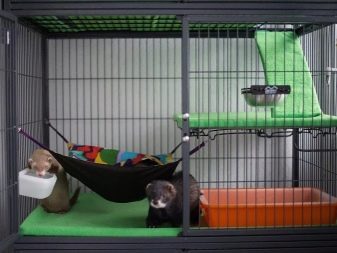
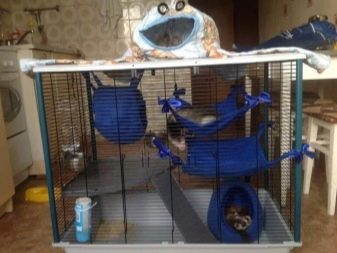
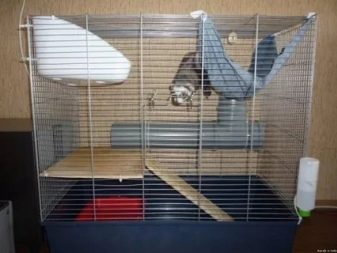
As you remember, ferrets like to dig into minks. Naturally, you are unlikely to let him delve into flower pots, so as an alternative, you can offer him various old rags, cardboard pipes, small boxes. There are special houses for ferrets, which are sold in pet stores. The main thing is that your pet shows interest in such facilities. If you see that a ferret doesn’t like an object, it’s better to remove it and come up with something else.
It is also necessary to install a feeding trough and a toilet in the cage. Fix these constructions well (you can use special suction cups), otherwise your animal may simply knock everything over, and then it will be more difficult for you to train him in basic skills.
If the conditions of your home allow you to allocate a ferret a separate room or balcony (loggia), then, of course, this will be a pleasant bonus for your pet. Large space and freedom of movement will appeal to your little friend. But this option is rather convenient for the animal, and not for the owner.
You need to be prepared for whatever your efforts to keep up with him everywhere, the ferret will still not leave you without surprises. Given his playful and restless disposition, you will have to find some traces of his tricks every now and then: broken things, scratched furniture, the results of the ferret not having time to reach the toilet.
Consider all possible options, think in advance where and in what conditions your pet will live: completely roam free or still be limited to the limits of the cell.
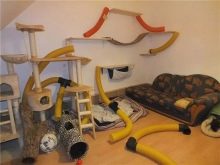
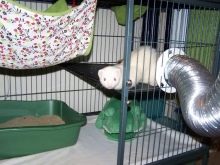

Food
The ferret is a predator, and therefore it must be provided with good nutrition. As a meal, it’s suitable:
- meat - it can be fresh beef, chicken, minced meat;
- fish, boiled eggs;
- dry food - it is best to consult a pet store and choose a special food, cat food may also be suitable;
- various cereals and vegetables.

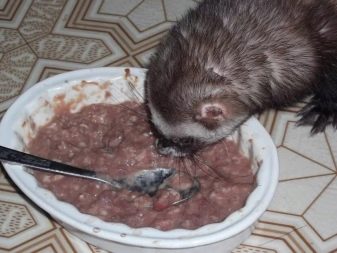
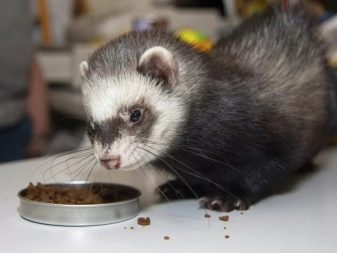

There are also products that are contraindicated for ferrets:
- too greasy and fried foods;
- all kinds of sweets, pastries;
- products containing coarse fiber and a large amount of fiber (carrots, citrus fruits);
- various kinds of nuts.
Whatever you feed the ferret, the main thing is to correctly compose a diet and provide his body with all the necessary substances. In some cases, you can give him fresh raw meat, for example, a whole ham or a small mouse.
Thus, you will create the conditions for the natural habitat and let the ferret again feel like a hunter. But not every owner will agree to this type of feeding.
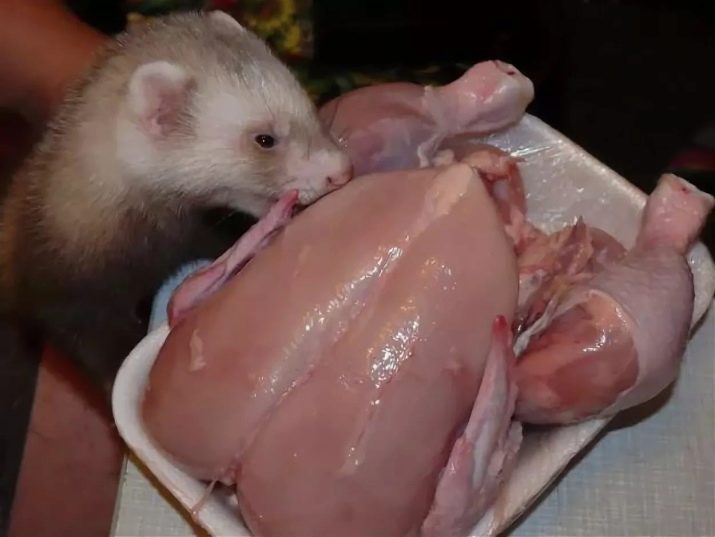
The right decision is to feed the finished feed. Moreover, they already contain all the necessary vitamins and minerals that play an important role in the harmonious development of your pet.However, such feeds are quite expensive, and besides, they are not sold everywhere. As a last resort, you can order them online.
Sometimes you can treat your pet with useful goodies - for example, give a try a banana, a slice of apple or melon. Feeding your pet is about 5-7 times a day, in small portions. Or limit yourself to breakfast, lunch and dinner, but then the serving size for 1 feeding will need to be increased. Also do not forget that the ferret is a fairly neat animal, so after each meal it will be necessary to wash its bowl, and only after that put a new portion of the feed.
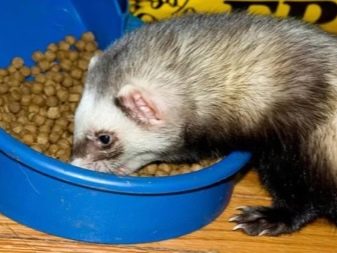

Hygiene
In order for your furry friend to feel comfortable and healthy, you must carefully monitor his hygiene.
First control his fur. To do this, buy special shampoos and wash your pet regularly - about 1 time per week. After water procedures, it is important to avoid drafts so as not to catch the animal, while the ferret is wrapped in a towel. You can also purchase special brushes for the proper combing of wool, and then the coat of your ferret will always have a well-groomed appearance.
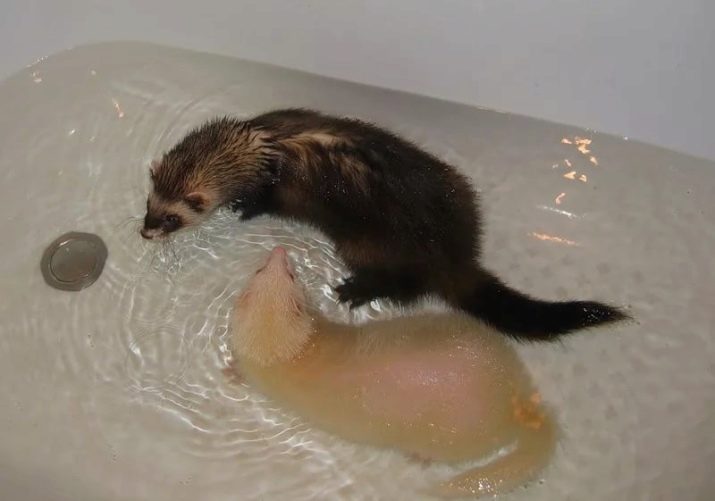
Another important aspect is claw care. In natural conditions, the ferret itself constantly grinds them when digging various holes and minks. In the home environment, you need to periodically trim the claw hoe. Firstly, this way you will protect your furniture from scratches, and secondly, when the claws grow strongly, this limits the movement of the animal, which brings him certain inconvenience. You can buy special claws.
The ferret must ensure a clean toilet. There are special fillers for trays that absorb all kinds of odors. After the animal fulfills its need, you must immediately remove everything and leave a clean tray.

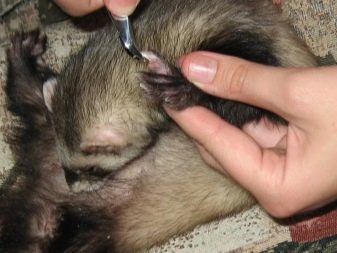
Owner reviews
Most people who bought a ferret speak positively about this animal. Many people like the fact that ferrets are active, you never have to get bored with them, such pets can easily have fun without a master. In addition, the ferret is well accustomed to the toilet, can live both in a cage and in a larger space.
There are also a lot of negative reviews. Ferret owners claim that animals constantly spoil something, do not always go to the toilet in a designated place, and require regular care. Some buyers of ferrets did not manage to fully cope with the character of the pet, and ferrets also have a negative attitude towards guests, which can also cause chagrin.
For more information on how to get hold of domestic ferrets, see the next video.
